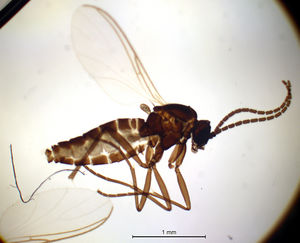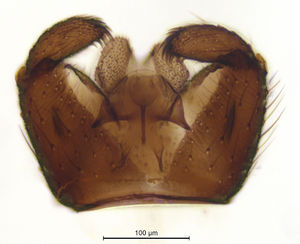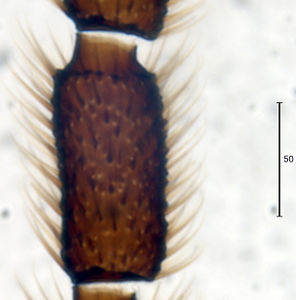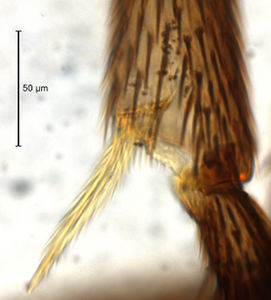Bradysia fenestrata
Ordo: Diptera
Familia: Sciaridae
Genus: Bradysia
Name
Bradysia fenestrata (Meigen, 1818) stat. rev. – ZooBank link
- Sciara fenestrata Menzel & Mohrig, 1998[1]: 281
Type material
Syntypes ♀♀ in MNHN
Type locality
Germany, Stolberg
Material studied
France: 1 ♂, Auvergne-Rhône-Alpes, Dienne, Cantal, Rocher de la Queuille, sweep netting, Heller, 28.07.2003, PKHH 4071; Germany: 1 ♂, North-Rhine-Westphalia, Köln-Poll, Garten, Malaise trap, Franzen, 30.4.-07.05.1991, PKHH 2985; 11 ♂, Köln-Dünnwald, Kg. Grüner Kuhweg, Malaise trap, Franzen, 4.-11.04.1989, PKHH 1223; 1 ♂, Köln-Poll, Garten, Malaise trap, Franzen, 11.-18.04.1989, PKHH 1269; 1 ♂, Rhineland-Palatinate, Niederzissen, Bausenberg Sockel Hufeisenkrater, Malaise trap, Rulik, 9.-23.08.2012, ZFMK ZFMK-TIS-2527961; 13 ♂, Schleswig-Holstein, Wankendorf, Brachgrünland, photoeclector, Hingst, 26.9.-09.10.1989, PKHH 234; 1 ♂, 1.-15.07.1988, PKHH 232; 3 ♂, Kiel-Universität, Gartengelände, light trapping, Kolligs, 21.-22.08.1996, PKHH 2567; 8 ♂, Putlos, Truppenübungsplatz, Malaise trap, Kassebeer, 13.-20.03.2014, ZFMK ZFMK-TIS-2583559; 1 ♂, Schierensee, Oberer Schierenseebach, emergence trap, Buske, 03.05.1991, PKHH 240; Slovakia: 3 ♂, Martin, Martinske hole, Buchen-, Fichtenwald, Wegrand, sweep netting, Heller, 25.07.2007, PKHH 5622; Sweden: 1 ♂, Ångermanland, Skuleskogen National Park, Långrå: brook ravine in mixed forest, Malaise trap, Swedish Malaise Trap Project, 9.-23.08.2004, NHRS 4450; 4 ♂, Darlana, Orsa, Wald- und Moorlandschaft Orsa-Grönklitt, sweep netting, Heller, 07.08.2006, PKHH 4984; 4 ♂, Skåne, Mölle, Skane län, Kullabergs naturreservat, Oak forest in southern slope, Malaise trap, Swedish Malaise Trap Project, 9.8.-20.09.2005, NHRS 2235, 2838.
Barcoded material studied
| Stadium | Country | Province | Locality | Habitat | Method | Date | Collector | Collection Number | Collection | Latitude | Longitude | Elevation (m) |
|---|---|---|---|---|---|---|---|---|---|---|---|---|
| 1 ♂ | Morocco | Tétouan | Jbel Zemzem | sweep netting | 23.04.2014 | Kettani | ZFMK-TIS-2593094 | ZFMK | 35.7333 | -5.35 | 21 | |
| 1 ♂ | Morocco | Tétouan | Oued Maggou | sweep netting | 07.02.2017 | El Ouazzani | ZFMK-TIS-2593070 | ZFMK | 35.31 | -5.43222 | 1067 | |
| 1 ♂ | Morocco | Tétouan | Oued Tkaraa | sweep netting | 07.05.2015 | Adghir | ZFMK-TIS-2593081 | ZFMK | 35.2908 | -5.43278 | 959 | |
| 1 ♂ | Norway | Sør-Trøndelag | Trondheim, Sommerlystvegen | garden | Malaise Trap | 20.07.2014 | E. Stur, T. Ekrem | BIOUG15964-D09 | NTNU | 63.405 | 10.383 | 65 |
| 1 ♂ | Norway | Hedmark | Hedmark, Ekeberget | Malaise Trap | 06.09.2014 | Olsen, K.M. | bf-sci-00714 | NHMO | 60.01 | 12.124 | 190 | |
| 1 ♂ | Norway | Vestfold | Larvik, Molen | sandy beach | Malaise Trap | 02.10.2009 | Gammelmo, O.; Olberg S.; Olsen, K.M. | bf-sci-00039 | NHMO | 58.9763 | 9.82046 | 1 |
| 1 ♂ | Norway | Rogaland | Haraldshaugen, Campsite | sweep netting | 17.08.2015 | Heller, K. | bf-sci-00888 | NHMO | 59.428 | 5.259 | 15 |
Description (male)
Head. Eye bridge 3 rows of facets. Antenna unicolour. LW-index of 4th flagellomere 1.8–2.2; neck 0.32–0.42 × segment width; Transition of basal part to neck pronounced. Colour of neck unicolour. Antennal setae shorter than segment width; of normal strength; dense. Sensillae present. Antennal setae salient. Palpus darkened; normal; palpomeres 3. First palpomere of normal shape; with 4–6 bristles; with delimited sensillary field. Second palpomere short, oval. Third palpomere as long as first segment. Thorax. Colour brown. Notum unicolour. Thoracic setae normal; black, or brown. Posterior pronotum bare. Mesothoracic sclerites bare. Legs. Colour brown. Hind coxa of same colour as femora. Hairs on fore coxa bright. Front tibia apically with a distinct, delimited comb. Front tibial organ bright. Tibial comb undivided. Tibial comb with 6–8 bristles. Front tibial organ not bordered. Tibial setae on hind legs weak, inconspicuous. Tibial spurs of equal length. Claws untoothed. Wing. Wing hyaline; with conspicuous anal lobe. Wing membrane without macrotrichia. Wing venation weak, with faint stM. M-fork of normal shape. R1 ending clearly before base of m-fork; posterior veins bare; bM bare; r-m bare; bM:r-M 1.9–2.1; st-Cu:bM 0.6–0.8; R1:R 0.55–0.75; c:w 0.6–0.73. Halter darkened; of normal length. Abdomen. Abdominal setae weak. Abdominal setae sparse. Tergal setae brown; sternal setae white, or of different colour. Hypopygium concolour with abdomen; 0.54–0.66 × longer than wide. Base of gonocoxites with normal, weak hairs; gonocoxites narrowly separated; inner margin of gonocoxites normally U-shaped, or V-shaped; inner membrane of hypopygium bare; elongated setae on gonocoxites absent. Gonostylus elongate; 2.2–2.6 × longer than wide; Inner margin straight, or convex; apex equally rounded. Apical tooth dorsally present; as long or longer than subapical megasetae; 4–6 × longer than broad; normal. Apical tooth without internal structure. Awl-like setae absent. Subapical megasetae present. Number of megasetae 9–11; megasetae thick; megasetae straight; megasetae in one group. Position of basalmost megaseta 18–26 % from top. Whiplash-hair absent. Tegmen 0.51–0.62 × longer than broad; equally rounded; without special features; Central process absent. Length of ejaculatory apodeme/hypopygium 22–28 %; Aeadeagal apical structure present. Field with aedeagal teeth present. Measurements. Body size 2–2.6 mm. Hind tibia 0.81–0.9 mm. Wing length 1.6–2.3 mm.
Diagnosis
Bradysia fenestrata is that species in the Bradysia nitidicollis complex with the most hyalinous wings. The wing veins are nearly not discernible. Otherwise B. fenestrata is quite dark, particularly the legs and it has strong, and black abdominal hairs. The antennae also have long hairs like in B. nitidicollis, but the flagellomeres are longer than in the latter species.
DNA Barcoding
The COI sequence is assigned to BIN BOLD:ACQ3588 (average distance 0.02%, max. 0.32%, n=31, K2P: 6.00%).
Ecology
B. fenestrata is commonly found in dry and sunny conditions, such as dunes and heather.
Discussion
For a long time this species has been considered to be identical to Bradysia niticicollis. Lengersdorf (1929)[2] was the first and almost only reviser of Meigen´s species and synonymized both names without any further comment. None of the later authors (Tuomikoski 1960[3], Menzel & Mohrig 2000[4]) have questioned that identity. However, Meigen describes Sciara fenestrata as "Schwarz; Taster und Beine pechbraun; Flügel glasartig" [Black; palpi and legs pitch-brown; wings shiny like glass] and Sciara nitidicollis as "Schwarz mit glänzendem Rükkenschilde Fühler kürzer als der Leib; Beine honiggelb; Flügel fast glasartig" [legs honey-coloured; wings nearly as shiny like glass]. The two main differences, the colour of legs and the difference in the transparency of the wings indeed separate both, very common species. It is therefore justified to reactivate the name fenestrata based on the original description. The female syntypes from the Natural History Museum of Paris, have not been studied directly, but photos of five pinned or glued specimens are available at the MNHN website: MNHN-ED-ED3484, MNHN-ED-ED3485, MNHN-ED-ED3486, MNHN-ED-ED3487 and MNHN-ED-ED3488. The second specimen, MNHN-ED-ED3485 is contrary to Meigen´s original label not a female, but a male and the photos show very well the completely hyalinous wings and the uniformly dark legs.
Etymology
lat. fenestra = window
Distribution
Belgium, France, Germany[1], Morocco[5], Norway, Slovakia, Sweden.
Images
|
References
- ↑ 1.0 1.1 Meigen, J.W. 1818: Systematische Beschreibung der bekannten europäischen zweiflügeligen Insekten (1-6, 1: v-xii, xxxvi). Friedrich Wilhelm Forstmann, Aachen.
- ↑ Lengersdorf, F. 1929: Les Sciarides (Lycoriidae) de la collection de J. W. Meigen. Encyclopédie Entomologique (Série B) II Diptera, 5(2), 55–61.
- ↑ Tuomikoski, R. 1960: Zur Kenntnis der Sciariden (Dipt.) Finnlands. Annales Zoologici Societatis Zoologicae Botanicae Fennicae “Vanamo”, 21, 1–164.
- ↑ Menzel, F.; Mohrig, W. 2000: Revision der paläarktischen Trauermücken (Diptera: Sciaridae). Studia dipterologica Supplement 6, 1-761. AMPYX-Verlag, Halle.
- ↑ El Ouazzani, N.E.H.; Heller, K.; Kettani, K. 2019: The first checklist of black fungus gnats (Diptera: Sciaridae) of Morocco. Annales de la Société entomologique de France (N.S.), 55(3), 274–290. doi: 10.1080/00379271.2019.1570826.




